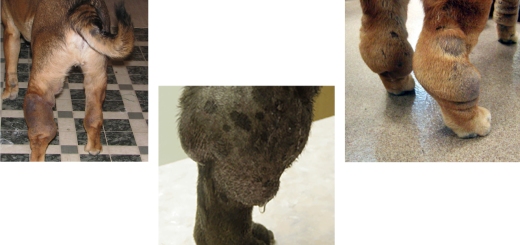Health and Behavior in the Shar-Pei
Often the first sign of disease in the Shar-Pei is a change in behavior or personality. This leads us to several conclusions. First, it is very important to know what the normal behavior of a particular dog is. While Shar-Pei possess several behaviors in common, there certainly exists wide variation among individuals. The veterinarian is usually not aware of the “normal” behavior of a specific dog and must rely on the owner to furnish that information. Second, the owner must understand that the veterinarian may want to pursue diagnostic testing in order to determine if the behavior changes are caused by an underlying physical disease problem. Third, it must be realized that dogs can have emotional or mental disease. Fourth, the behavior of a dog can vary because of age, stress, environment, interactions with other animals and people, smells sounds, etc. Also we need to realize that behavior is not “static”-it changes over time.
There can be considerable overlap between the behavioral changes related to disease and the physical disease itself. Behaviors are categorized into eating, drinking, sleeping, elimination, play, and a nebulous category known as “personality”. Changes in personality are the most highly variable and difficult to grasp. Owners know when their pet is “not acting like herself”, but cannot often describe this change in specific terms. Personality includes interactions with the owner, other people, other dogs and other animals and covers areas such as aggression, dominance, territoriality, etc.
Disease can influence behavior in several ways. Diseases such as liver disease, kidney disease, diabetes mellitus, bacterial diseases resulting in septicemia such as pyometra and others are associated with the accumulation of waste products in the blood which effect the brain causing depression, slow mentality and changes in personality. Other diseases can cause generalized weakness, which can effect the dog’s responses and behavior. Addison’s (hypoadrenocorticism), myasthenia gravis, and hypothyroidism are examples of diseases causing weakness. Diseases resulting in fever can manifest as changes in behavior and personality. Familial Shar-Pei Fever is a prime example of this. Shar-Pei in an FSF episode show several typical behavior changes related to the fever and pain of the disease – decreased appetite, decreased activity, pain often with aggression, and personality changes which alert the owner that this dog is sick. Aggression often manifests itself in diseases characterized by pain. Examples include FSF (painful hocks), degenerative joint disease (arthritis), abscesses, some types of cancer, glaucoma, etc.
There are primary behavioral disorders in dogs now being studied. These include separation anxiety, obsessive-compulsive disorders and others. These can be managed through behavior modification and drug therapy. Perhaps some forms of aggression and dominance behavior also fit into this category.
What clues tell us that a change in behavior might be caused by disease? The following are general guidelines:
- Duration of the abnormal behavior. The longer the abnormal behavior continues the greater the chance it is caused by an underlying disease process.
- Behavior changes vs. personality changes. Changes in behavior are more often associated with disease than are changes in personality.
- Behavior changes with accompanying physical changes. Behavior changes with physical changes such as weight loss, vomiting, diarrhea, etc. are more often associated with disease.
- Abrupt changes in behavior. Generally, rapid changes in behavior are associated with a disease process.
Often, specific behavior changes help to pinpoint the problem. A dog with a head tilt and constant scratching of the ear on that side probably has an ear infection. A dog that begins to strain to urinate and urinate more often probably has some type of urinary problem. Other changes in behavior are not specific enough to help us define the problem. An example is loss of appetite. Can the dog eat, but he chooses not to? Or is the dog physically unable to eat? Or is the dog not eating as much as the owner thinks he should?
Another aspect of behavior involves hormonal influences in intact animals. Almost any behavior change, which occurs during a female’s heat cycle, can be normal. Most females tend to not show extreme behavior changes, but the changes in behavior seen tend to be consistent for that individual. Males, likewise, can show behavior changes when females are in heat. Many males show decreased appetite and increased activity in the spring and fall coinciding with the heat cycles of females. Some males become irritable at these times of the year as well resulting in aggression or increased territorial behavior.
A consistent period of behavior changes occurs in geriatric dogs. These are behaviors associated with senility. The brain begins to wear out in old age just as other body systems do. Many older pets develop inattention, selective hearing, pacing, stereotypic licking behavior, “zoning out” behavior (staring at a wall for several minutes) and other abnormal behaviors. These are changes that manifest themselves without underlying disease or metabolic changes.
Many behaviors are caused by emotional problems. These can be due to changes in environment, routine, pack order, loss of another dog or family member, etc. In this category we place obsessive-compulsive disorders, separation anxiety, overly aggressive behaviors, destructive chewing, inappropriate elimination and others. Here we get into the “genetic vs. environment” controversy – are emotional problems inherited or related to early social interactions? I do believe we see some lines where temperament is a problem so I feel genetics does play a significant role in behavior.
In conclusion, there are not really specific changes in behavior, which serve as a marker for specific diseases. Changes in behavior tell us a problem exists and then it’s up to the veterinarian and the owner to begin to piece the puzzle together. Very often this involves preliminary diagnostics such as blood work, radiographs, urinalysis,etc. The real challenge often involves some detective work to determine what changes in the dog’s environment may have contributed to the problem.
